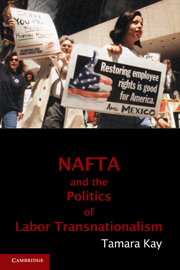PART TWO - VARIATIONS IN TRANSNATIONALISM
Published online by Cambridge University Press: 05 June 2012
Summary
The first part of the NAFTA story centers on how the trade agreement's institutional structures created new transnational opportunities for labor unions that led to the emergence of labor transnationalism in North America in the early 1990s. Despite the strength of NAFTA's effect, however, not all unions developed transnational relationships in its wake. NAFTA's power to catalyze transnational labor relationships was significant, yet for some unions its effects were constrained by political and ideological factors that left the landscape of North American labor relationships significantly, though unevenly, transformed. In order to understand NAFTA's catalytic effect on North American unions, then, we must examine not only the nature of the transnational political opportunity structure it created but also the unique characteristics of unions poised to take advantage of it.
The NAFTA story, then, has a sequel. Whereas the first part of the story centers on structure, the second focuses on agency, specifically how unions responded differently to those opportunities. Part Two of the book therefore examines variations in unions' engagement in transnational activities in response to NAFTA. Chapter 6 examines the unions that did not take advantage of the opportunity provided by NAFTA, and Chapter 7 offers a more detailed analysis of the variation between unions that embraced and rejected transnationalism. A comparison of the positive and negative cases is essential because it highlights the predisposing characteristics that made some unions more susceptible to NAFTA's catalytic effect.
- Type
- Chapter
- Information
- NAFTA and the Politics of Labor Transnationalism , pp. 197 - 198Publisher: Cambridge University PressPrint publication year: 2011

